Bohol Public Transport Cheat Sheet: Your Stress-Free Guide to Navigating the Island. Master Bohol’s public transport with this easy guide, covering buses, vans, and tricycles for affordable and convenient island exploration. Get ready to see the sights with confidence!
Exploring the beautiful island of Bohol can be incredibly rewarding, but figuring out how to get around can sometimes feel like a puzzle. Many travelers find themselves wondering about the best and most budget-friendly ways to reach the famous Chocolate Hills, pristine beaches, or charming towns. Don’t worry; navigating Bohol’s public transport is simpler than you think!
This guide is designed to be your go-to resource, breaking down all the options. We’ll cover everything from catching a bus to hopping on a local tricycle. Get ready to feel confident about your island adventures, knowing you’ve got the insiders’ scoop on getting from point A to point B, comfortably and affordably. Let’s make your trip smooth sailing!
Understanding Bohol’s Public Transport Landscape
Bohol, an island paradise in the Philippines, offers a delightful mix of natural wonders and cultural experiences. To truly immerse yourself in what Bohol has to offer, understanding its public transportation system is key. It’s a system that’s both practical and, for the most part, budget-friendly, making it accessible for all kinds of travelers.
The main modes of public transport you’ll encounter are buses, vans (often called “vans for hire” or V-Hires), and tricycles. Each has its own advantages depending on where you’re going, how much luggage you have, and your comfort preferences. Think of them as your friendly chariots, ready to take you on your next adventure across the island.
For first-time visitors, especially those with families or carrying essentials like diapers for children or adults, knowing the options upfront can significantly reduce travel stress. This guide will equip you with the knowledge to choose the best transport for your needs, ensuring your journeys are as enjoyable as the destinations themselves.
The Mighty Bohol Bus: Your Long-Distance Companion
The Bohol bus system is the backbone of inter-town and long-distance travel on the island. If you’re planning to traverse significant distances, like from Tagbilaran City to the northern or eastern parts of Bohol, the bus is likely your best bet. They are reliable, frequent, and very economical.
Buses operating in Bohol are generally well-maintained and offer different seating configurations. Some are air-conditioned, providing a comfortable ride, especially during the hotter months. Others are non-air-conditioned, which are even more budget-friendly. The choice might depend on your personal preference for comfort versus cost.
Where to Catch a Bohol Bus
The main hub for inter-provincial and inter-town buses in Bohol is the Tagbilaran City Integrated Bus Terminal. This terminal is a central point where you can find buses heading to various destinations across the island. For smaller towns, local bus stops will be designated along main roads.
When you arrive in Tagbilaran City (likely via ferry or plane), you can easily find a tricycle or taxi to take you to the bus terminal. Once there, look for the departure area based on your destination. Signs are usually clear, and local staff can assist you if you’re unsure.
Popular Bus Routes and Estimated Fares
Here’s a glimpse of some common bus routes originating from Tagbilaran City. Fares are approximate and can change, but this gives you a good idea of the affordability.
| Destination | Estimated Travel Time | Approximate Fare (PHP) |
|---|---|---|
| Panglao (Tagbilaran Airport/Alona Beach area) | 30-60 minutes | 30-50 |
| Baclayon Church | 30-40 minutes | 20-30 |
| Loboc River Cruise Area | 1 hour | 40-60 |
| Bilar (Chocolate Hills viewpoint jump-off) | 1.5 – 2 hours | 70-100 |
| Carmen (Chocolate Hills viewpoint) | 2 – 2.5 hours | 80-120 |
| Anda (Eastern Bohol coast) | 3 – 3.5 hours | 150-200 |
| Ubay (Northern Port) | 3 – 4 hours | 180-250 |
Note: Fares are subject to change. It’s always a good idea to confirm the latest prices at the terminal.
Tips for Bus Travel in Bohol
- Boarding: You can often flag down buses on their route if you’re on a major road, not just at terminals, but paying the conductor directly.
- Luggage: Larger luggage is usually stored in the undercarriage. Inform the conductor about your bags. If you’re traveling with essentials like comfortable adult diapers for long journeys or child diapers for little ones, ensure they are safely packed.
- Comfort: If riding during peak hours or hot weather, opt for air-conditioned buses if available.
- Payment: Payment is made to the conductor onboard. Keep small bills handy for easier transactions.
Van for Hire (V-Hire): The Speedy Alternative
Vans for Hire, or V-Hires, are a popular choice for a faster and more direct journey between major towns in Bohol. They offer a middle ground between the space of a bus and the individual attention of a private hire. V-Hires typically have fixed routes and schedules, though they often depart once full.
These vans are usually more comfortable than non-air-conditioned buses, and their quicker travel times make them attractive for those on a tighter schedule or who prefer a more direct route. They are a common sight on main highways connecting key tourist destinations.
How V-Hires Work
V-Hires operate on specific routes, usually connecting larger towns or hubs. Unlike buses that might have many stops, V-Hires tend to make fewer stops, primarily at designated terminals or major junction points. They depart when they have enough passengers to fill the van, so departure times can be flexible.
You can find V-Hire terminals in Tagbilaran City and in the central parts of other major towns like Panglao, Baclayon, Loboc, and Carmen. They are a convenient way to travel between these popular spots.
Common V-Hire Routes and Durations
V-Hires are excellent for certain popular routes:
- Tagbilaran to Panglao (Alona Beach): This is a very frequent route. The trip takes about 30-45 minutes.
- Tagbilaran to Carmen (Chocolate Hills jump-off): A quicker alternative to the bus for this route, taking around 1.5 to 2 hours.
- Tagbilaran to Loboc: Direct trips are available, making it easy to reach the river cruise area.
Fares for V-Hires are generally slightly higher than buses for similar distances, reflecting the faster travel time and (often) air-conditioned comfort. Expect fares to be in the range of PHP 80-150 for common tourist routes, but always check locally.
Getting Your Gear in a V-Hire
Space in V-hirs can be tighter than in buses. While most vans have overhead compartments or can accommodate smaller bags, large suitcases might need to be stowed in the front passenger area or the back, if space permits. If you’re traveling with an infant and their essentials, including diapers, ensure they are in a manageable bag.
For adults needing discreet and comfortable diaper solutions for travel, packing travel-sized packs or ensuring your chosen adult diapers are easily accessible can be a lifesaver. Consider options designed for long wear and discretion, ensuring comfort throughout your journey.
The Quintessential Tricycle: Your Local Navigator
No trip to Bohol is complete without experiencing a ride in a tricycle. These ubiquitous motorized rickshaws are the workhorses of local transportation, especially within towns and for shorter distances. They are perfect for getting from your accommodation to a bus stop, exploring a local market, or reaching a nearby attraction that’s a bit too far to walk.
Tricycles are typically small, three-wheeled vehicles with a motorcycle at the front and a covered carriage for passengers at the back. Seating capacity varies, but they usually accommodate 2-4 passengers comfortably, or more if you squeeze in! They are the most common and often the only way to get around within smaller towns and tourist hubs like Panglao Island.
When to Use a Tricycle
Tricycles are ideal for:
- Short town-to-town trips.
- Getting from your resort or hotel to the nearest transport hub (bus terminal, V-hire station).
- Exploring within tourist areas like Panglao town, Tagbilaran City proper, or specific attractions if they are not directly on a bus route.
- Cruising around smaller villages to soak in the local atmosphere.
Haggling for Fares
Fares for tricycles are typically negotiated before starting your journey, especially if you are a tourist. While there are often set rates within a town, it’s good practice to ask for the fare beforehand. Tricycle drivers are generally friendly and will be happy to tell you the price.
For short trips within a town (e.g., from a hotel to the main road in Panglao), expect fares to be around PHP 50-100. Longer distances, or special trips outside of the usual routes, will cost more. If you have a lot of luggage, they might charge a little extra. For families needing space, consider taking two tricycles if everyone and their bags won’t fit comfortably. This also ensures a more relaxed ride, especially for younger children or if you need to manage items like baby diapers or personal care items discreetly.
Tricycle Etiquette and Tips
- Negotiate First: Always agree on the price before getting in.
- Group Travel: If traveling with others, you can often split the cost of a single tricycle ride, making it more economical.
- Ask Locals: If unsure about a reasonable fare, discreetly ask your hotel staff or a local vendor.
- Be Patient: Sometimes tricycles can be slow, especially on bumpy roads. Enjoy the ride!
- Safety: Ensure the tricycle feels sturdy and the driver is alert. If you have any doubts, choose another one.
Navigating Bohol with Specific Needs
For many travelers, especially families with young children or individuals with specific health requirements, planning transportation needs a little extra thought. Journey Essentials understands that comfort, convenience, and dignity are paramount when traveling.
Traveling with Children
When traveling with kids, especially toddlers or infants, comfort is key. Buses and V-Hires are generally more comfortable for longer journeys. Ensure you have easy access to essentials like snacks, water, and, of course, child diapers. Having a dedicated travel bag for these items makes life so much easier. Tricycles are great for short, fun trips but can be cramped for a family needing space. If using a tricycle for a short hop, securing little ones on laps is common, but always prioritize safety.
Adult Diaper Needs for Travelers
For adults who require adult diapers, long travel days or navigating unfamiliar public transport can sometimes raise concerns. The peace of mind that comes with knowing you have reliable, comfortable protection is invaluable. For bus and V-hire journeys, ensure your adult diapers are packed in an easily accessible part of your luggage or a day bag. Look for brands that offer discretion and high absorbency for extended wear, allowing you to focus on enjoying Bohol’s sights rather than worrying about your comfort.
Remember, discreet packaging and easy-to-carry options are available, making it practical to bring what you need for stress-free exploration. For example, brands like Depend offer a range of products designed for active lifestyles, many of which are suitable for travel.
Combining Transport Modes: The Smart Explorer’s Strategy
The most efficient way to explore Bohol often involves combining different modes of transport. This strategy allows you to leverage the strengths of each option:
- Tagbilaran City as a Hub: Arrive in Tagbilaran (by ferry or plane). From the port or airport, take a tricycle to the bus terminal or V-hire station.
- Long Distances: For destinations far from Tagbilaran (e.g., Anda, Ubay, or directly to Carmen), take a bus for its affordability and space.
- Mid-Range Travel: If you’re heading to popular spots like Loboc or Chocolate Hills and want a slightly faster trip than a bus, a V-hire is a good choice.
- Local Exploration: Once you reach your main destination (like Panglao, Loboc, or near Carmen), use tricycles for getting around town, to your accommodation, or to specific attractions not right on the main road.
This approach ensures you’re not overpaying for short trips and can manage your luggage and comfort levels effectively throughout your journey.
Key Destinations and How to Reach Them
Let’s break down reaching some of Bohol’s star attractions:
Chocolate Hills
From Tagbilaran: The most common way is to take a bus or V-hire heading towards Carmen. Get off at the Bilar junction or directly in Carmen town. From there, you’ll likely need a tricycle or habal-habal (motorcycle taxi) to the main viewpoint. The total travel time is about 2-2.5 hours.
Panglao Island (Alona Beach, Dumaluan Beach)
From Tagbilaran: Buses and V-hires heading to Panglao town or Alona Beach are frequent. The journey takes about 30-60 minutes. Once in Panglao, tricycles are the primary mode of transport to reach your specific resort or beach.
Tarsier Sanctuary (Corella)
From Tagbilaran: Buses heading towards Tubigon or Clarin will pass by Corella. You can ask the conductor to drop you off near the turn-off for the Tarsier Sanctuary. From the main road, it’s a short tricycle or habal-habal ride to the sanctuary. Alternatively, some tours include transport.
Loboc River Cruise
From Tagbilaran: Buses and V-hires heading towards the south (e.g., towards Anda or Carmen via the southern route) often pass through Loboc. Ask to be dropped off at the River Cruise docking area. It’s about an hour’s journey.
For information on national transport policies and safety standards, you can refer to the Land Transportation Franchising and Regulatory Board (LTFRB) website.Bohol Public Transport Cheat Sheet: Summary Table
Here’s a quick reference table to help you decide:
| Transport Mode | Best For | Pros | Cons | Approx. Cost (Relative) |
|---|---|---|---|---|
| Bus | Long distances, budget travel | Affordable, comfortable (AC options), frequent on main routes, good luggage space | Slower due to stops, can be crowded during peak hours | $ |
| Van for Hire (V-Hire) | Mid-range distances, faster travel | Quicker than buses, air-conditioned, direct routes between major hubs | Slightly more expensive than buses, can be cramped, departs when full | $$ |
| Tricycle | Short distances, intra-town travel, local exploration | Ubiquitous, convenient for local access, good for short hops, atmospheric | Fares need negotiation, can be bumpy, limited seating, slower on longer routes | $$ (for longer trips or private hires) |
Cost key: $ = Very Affordable | $$ = Moderately Affordable | $$$ = More Expensive




